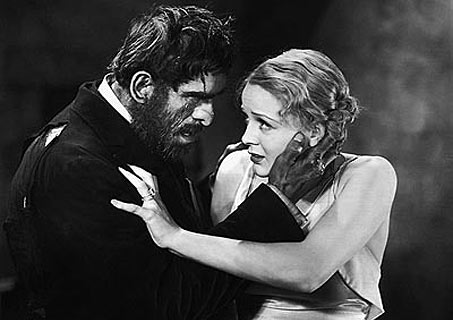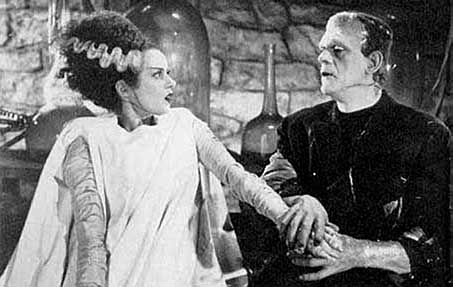|
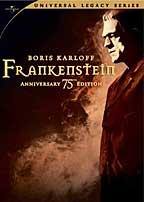
Frankenstein
Universal,
1931
Director:
James Whale
Screenplay:
John L. Balderston, from the novel by Mary Shelley
Starring:
Colin Clive, Boris Karloff, Mae Clarke, Edward Van Sloan, Dwight Frye
Unrated, 71 minutes

The
Old Dark House
Kino
Video, 1932
Director:
James Whale
Screenplay:
Benn W. Levy
Starring:Boris
Karloff, Melvyn Douglas, Charles Laughton, Lilian Bond, Ernest Thesiger,
Eva Moore, Raymond Massey, Gloria Stuart
Unrated, 72 minutes

The
Bride Of Frankenstein
Universal,
1935
Director:
James Whale
Screenplay:
John L.William Hurlbut
Starring:
Colin Clive, Boris Karloff, Valerie Hobson, Ernest Thesiger, Elsa Lanchester,
Gavin Gordon, Douglas Walton, Una O'Connor
Unrated, 75 minutes
|
Of
Gays And Ghouls
by
Michael D. Klemm
Reprinted
from Outcome, January,
1999

Sir Ian McKellen
recently starred on the big screen at the Amherst Theatre (in a tour de
force performance) as gay film director James Whale in Gods
and Monsters. This month, for a change of pace, Outcome
takes a new look at several of Whale's classic films from the 1930s.
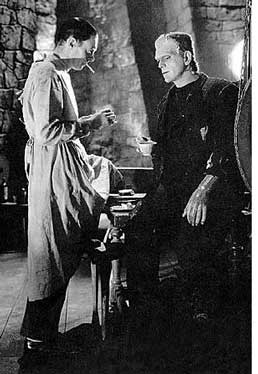 James
Whale (1889-1957) will always be remembered as the director of
Frankenstein, The Invisible Man and The
Bride of Frankenstein. Born in England, he won acclaim
in 1929 for the London production of an anti-war play called Journey's
End, which he was invited to re-stage in New York City. A year later
he made his directorial debut in Hollywood with its film version, and
then went on to create what many consider to the greatest American horror
films. His oeuvre also includes a terrific exercise in Grand Guignol called
The Old Dark House, as well
as several melodramas and comedies. Whale helmed the second (many critics
say the best) film version of Showboat with a cast that included
Paul Robeson. James
Whale (1889-1957) will always be remembered as the director of
Frankenstein, The Invisible Man and The
Bride of Frankenstein. Born in England, he won acclaim
in 1929 for the London production of an anti-war play called Journey's
End, which he was invited to re-stage in New York City. A year later
he made his directorial debut in Hollywood with its film version, and
then went on to create what many consider to the greatest American horror
films. His oeuvre also includes a terrific exercise in Grand Guignol called
The Old Dark House, as well
as several melodramas and comedies. Whale helmed the second (many critics
say the best) film version of Showboat with a cast that included
Paul Robeson.
He left Universal
Studios following the butchering of his opus, The Road Back, the
sequel to All Quiet On The Western Front (due to Nazi interference
of all things). He made his last film in 1949 and then retired from the
film business. Though Whale did not advertise that he was gay, neither
did he hide it. He lived for over twenty years with his lover, producer
David Lewis. At the age of 67, following a debilitating stroke, Whale
committed suicide by diving into the shallow end of his swimming pool.
 Frankenstein
(1931), a loose adaptation of Mary Wollstonecraft Shelley's novel, established
Whale's reputation in Hollywood. The script dispensed with most of Shelley's
psychological drama in favor of more action and thrills. Colin Clive stars
as Dr. Henry Frankenstein, a young scientist whose obsession clouds his
reason when he attempts to endow the spark of life on a creature assembled
from various dead bodies. According to Gods
and Monsters, it was Whale who first sketched the creature's look,
creating such an effective icon that even today it is still universally
recognized as Frankenstein's monster. Boris Karloff's first appearance
as the monster is accompanied by a startling jump-cut to his face in tight
close-up which terrified the less sophisticated audiences of its day. Frankenstein
(1931), a loose adaptation of Mary Wollstonecraft Shelley's novel, established
Whale's reputation in Hollywood. The script dispensed with most of Shelley's
psychological drama in favor of more action and thrills. Colin Clive stars
as Dr. Henry Frankenstein, a young scientist whose obsession clouds his
reason when he attempts to endow the spark of life on a creature assembled
from various dead bodies. According to Gods
and Monsters, it was Whale who first sketched the creature's look,
creating such an effective icon that even today it is still universally
recognized as Frankenstein's monster. Boris Karloff's first appearance
as the monster is accompanied by a startling jump-cut to his face in tight
close-up which terrified the less sophisticated audiences of its day.
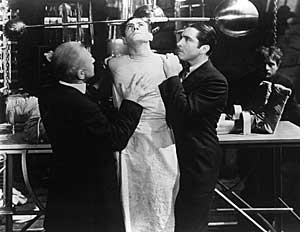 But
it is during the "non-horror" scenes involving the monster where
Whale's film really shines. Karloff brought a remarkable sensitivity to
his role. In the most striking scene, the monster meets a small girl by
a lake. The girl, unafraid, gives him some flowers. Like a child, filled
with blissful innocence, he marvels at the flowers as they both toss them
into the lake to watch them float. When they run out of flowers, he reaches
for the child, smiling. At this point, the film originally cut away to
Dr. Frankenstein's wedding celebration in the village. But today's video
release restores the end of that scene, which was cut by the censors in
1931. The monster picks up the girl and tosses her into the water, expecting
her to float in the same way. Instead she sinks and drowns, and the monster,
confused and terrified, flees the scene. But
it is during the "non-horror" scenes involving the monster where
Whale's film really shines. Karloff brought a remarkable sensitivity to
his role. In the most striking scene, the monster meets a small girl by
a lake. The girl, unafraid, gives him some flowers. Like a child, filled
with blissful innocence, he marvels at the flowers as they both toss them
into the lake to watch them float. When they run out of flowers, he reaches
for the child, smiling. At this point, the film originally cut away to
Dr. Frankenstein's wedding celebration in the village. But today's video
release restores the end of that scene, which was cut by the censors in
1931. The monster picks up the girl and tosses her into the water, expecting
her to float in the same way. Instead she sinks and drowns, and the monster,
confused and terrified, flees the scene.
The mood of Frankenstein
is heavily influenced by the German Expressionist horror films of the
1920s. Large shadows loom on the walls, tall sets with impossibly high
ceilings dwarf the characters onscreen. While it might seem a tad stiff
in spots, and perhaps even a bit corny, to modern audiences, there is
no denying that it generates far more style and mood than most of today's
gorier scare flicks.
|
|
Whale loosened up
a lot with The Old Dark House
(1932), a bizarre little film with an all-star cast that, along with Frankenstein,
would someday provide the inspiration for The
Rocky Horror Picture Show.
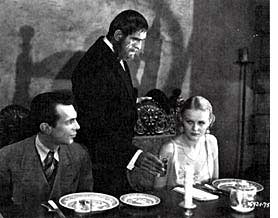 A
car breaks down during a rainstorm, forcing actors Raymond Massey, Gloria
Stuart, (yes, the same Gloria Stuart from the framing story in Cameron's
Titanic), and Melvyn Douglas to take refuge in a foreboding old
mansion. They are later joined by two other stranded motorists played
by Charles Laughton and Lillian Bond. A
car breaks down during a rainstorm, forcing actors Raymond Massey, Gloria
Stuart, (yes, the same Gloria Stuart from the framing story in Cameron's
Titanic), and Melvyn Douglas to take refuge in a foreboding old
mansion. They are later joined by two other stranded motorists played
by Charles Laughton and Lillian Bond.
They are welcomed
at the door by a monstrous, mute butler named Morgan (Boris Karloff).
The masters of the house are the elderly Horace and Rebecca Femm. Like
Rocky Horror's Riff Raff and Magenta, they are siblings... and
there are subtle suggestions of incest. Horace invites his wet guests
to sit by the fire while his sister Rebecca repeatedly shrieks that there
are no beds.
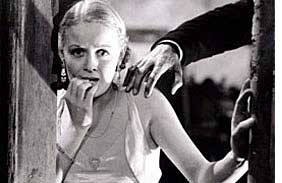 Hints
are dropped about the existence of a mad relative in the attic. It soon
becomes apparent that everyone in the house is a bit touched. Especially
Rebecca, who rants about "wickedness" in their family's past.
In the film's weirdest moment, Gloria Stuart changes her wet clothes while
the old woman speaks of her blasphemous father. "You're wicked too,"
she says suddenly, admonishing the young woman. "You think of nothing
but your long straight legs and your white body and how to please your
man." She fingers the edge of Staurt's dress and says "This
is fine stuff, but it will rot," and then touches Stuart's bosom
and says "That's finer stuff still, but it will rot too in time."
Stuart screams and flees the room. Like the antagonists of the later Rocky
Horror, the inhabitants of The Old Dark
House seem to be Hollywood monsters primarily because of
seemingly perverse sexuality. Hints
are dropped about the existence of a mad relative in the attic. It soon
becomes apparent that everyone in the house is a bit touched. Especially
Rebecca, who rants about "wickedness" in their family's past.
In the film's weirdest moment, Gloria Stuart changes her wet clothes while
the old woman speaks of her blasphemous father. "You're wicked too,"
she says suddenly, admonishing the young woman. "You think of nothing
but your long straight legs and your white body and how to please your
man." She fingers the edge of Staurt's dress and says "This
is fine stuff, but it will rot," and then touches Stuart's bosom
and says "That's finer stuff still, but it will rot too in time."
Stuart screams and flees the room. Like the antagonists of the later Rocky
Horror, the inhabitants of The Old Dark
House seem to be Hollywood monsters primarily because of
seemingly perverse sexuality.
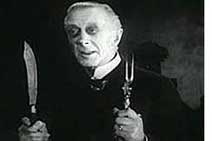 Stylishly
filmed, The Old Dark House
is a one-of-a-kind film peppered by fine performances from a stellar cast.
Using the framework of a horror story, Whale let his talents loose and
created a camp masterpiece. While not a traditional thriller, The
Old Dark House is nevertheless creepy and moody. Stylishly
filmed, The Old Dark House
is a one-of-a-kind film peppered by fine performances from a stellar cast.
Using the framework of a horror story, Whale let his talents loose and
created a camp masterpiece. While not a traditional thriller, The
Old Dark House is nevertheless creepy and moody.
|
|
The
Bride of Frankenstein
(1935) is filled with wondrous scenes, rivaled perhaps only by The
Wizard of Oz as the most magical movie of the 1930s. Much less a horror
film than its predecessor, The Bride
is filled with touches of camp humor which make it the most fun of all
of Whale's movies. The Bride
begins as Mary Shelley (Elsa Lancaster) tells the continuation of her
story to her husband and Lord Byron during a thunderstorm. The actors
playing the two men are suitably poofy and Byron pontificates that "I
should like to think that an irate Jehovah was pointing these arrows of
lightning at the unbowed head of Lord Bryon, England's greatest sinner."
The scene then dissolves to a burning windmill where the monster supposedly
was killed in the original film. Minnie, an old woman who is dressed in
a goofy Austrian maid's outfit (the inspiration for Frau Blucher in Mel
Brook's Young Frankenstein) encounters the monster (Boris Karloff)
leaving the ruined windmill and runs shrieking back to town.
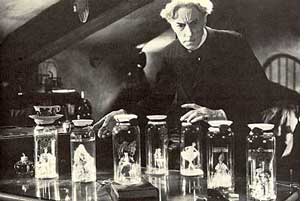 Dr.
Frankenstein (Colin Clive again) lies in a swoon following his ordeal,
lamenting that "perhaps death is sacred and I profaned it."
He is visited during the night by Dr. Pretorius (The Old Dark House's
Ernest Thesiger). Minnie, the housekeeper, describes him as a "queer
old looking gentleman." It is worth noting that Pretorius interrupts
Dr. Frankenstein and his bride on their wedding night. Pretorius has "grown"
life in jars and wishes to join forces with the doctor. "To Gods
and monsters," he announces as the two men drink a toast. The scene
were he displays a series of jars containing tiny living kings, queens,
bishops and ballerinas is one of the most magical in the history of film
(and a marvel of special effects considering its day.) "Science,"
he tells Dr. Frankenstein, "like love, has her little surprises as
you shall see." Dr.
Frankenstein (Colin Clive again) lies in a swoon following his ordeal,
lamenting that "perhaps death is sacred and I profaned it."
He is visited during the night by Dr. Pretorius (The Old Dark House's
Ernest Thesiger). Minnie, the housekeeper, describes him as a "queer
old looking gentleman." It is worth noting that Pretorius interrupts
Dr. Frankenstein and his bride on their wedding night. Pretorius has "grown"
life in jars and wishes to join forces with the doctor. "To Gods
and monsters," he announces as the two men drink a toast. The scene
were he displays a series of jars containing tiny living kings, queens,
bishops and ballerinas is one of the most magical in the history of film
(and a marvel of special effects considering its day.) "Science,"
he tells Dr. Frankenstein, "like love, has her little surprises as
you shall see."
 Meanwhile,
the monster hears the sound of a violin playing "Ave Maria"
and comes upon a cottage in the forest. Inside lives an old blind man
who invites the monster into his home. He holds out his hands to the monster,
who is overwhelmed by his charity, and gives him food and shelter. During
his stay, the monster learns how to speak - and how to smoke cigars. The
old man tells him that it is "bad to be alone" and the monster
smiles at him and says "Friend. Good." These scenes are unforgettable,
especially when the old blind man holds the crying monster's hands and
thanks God for bringing him a friend. Meanwhile,
the monster hears the sound of a violin playing "Ave Maria"
and comes upon a cottage in the forest. Inside lives an old blind man
who invites the monster into his home. He holds out his hands to the monster,
who is overwhelmed by his charity, and gives him food and shelter. During
his stay, the monster learns how to speak - and how to smoke cigars. The
old man tells him that it is "bad to be alone" and the monster
smiles at him and says "Friend. Good." These scenes are unforgettable,
especially when the old blind man holds the crying monster's hands and
thanks God for bringing him a friend.
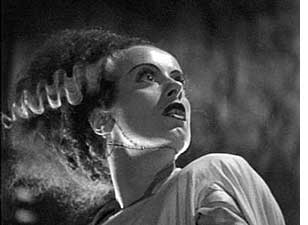 Of
course, their idyllic friendship doesn't last. Society intervenes and
drives the monster from the old man's cottage. The monster flees to a
graveyard where he topples several religious statues. Pretorius later
finds the monster hiding in a crypt and promises him that he and Dr. Frankenstein
will make him a mate. His mate, (Elsa Lancaster), is an even more striking
creation with jutting black hair, streaked by lightning. Using the framework
of a conventional heterosexual courtship, Whale indulges in parody as
the monster shyly takes the hand of his mate. In a scene of great pathos,
the monster is rejected by his bride. With tears in his eyes, he states
that they belong dead. He allows Dr. Frankenstein and his bride to leave
the castle (but not Dr. Pretorius) and then blows up the laboratory. The
Bride of Frankenstein
is a rare film that mixes horror with gallows humor, deep humanity and
large doses of camp. It is truly an American classic. Of
course, their idyllic friendship doesn't last. Society intervenes and
drives the monster from the old man's cottage. The monster flees to a
graveyard where he topples several religious statues. Pretorius later
finds the monster hiding in a crypt and promises him that he and Dr. Frankenstein
will make him a mate. His mate, (Elsa Lancaster), is an even more striking
creation with jutting black hair, streaked by lightning. Using the framework
of a conventional heterosexual courtship, Whale indulges in parody as
the monster shyly takes the hand of his mate. In a scene of great pathos,
the monster is rejected by his bride. With tears in his eyes, he states
that they belong dead. He allows Dr. Frankenstein and his bride to leave
the castle (but not Dr. Pretorius) and then blows up the laboratory. The
Bride of Frankenstein
is a rare film that mixes horror with gallows humor, deep humanity and
large doses of camp. It is truly an American classic.
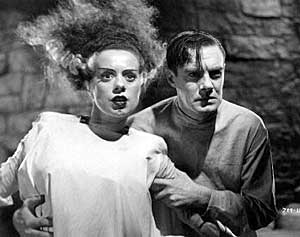 There
was no "gay scandal" that drove Whale from Hollywood. Whale
ended his own career himself when he left Universal Studios two years
later following the ruin of The Road Back. A fictional look at
his last days can be seen in the current Gods
and Monsters. At this writing, the film's run has already ended
at the Amherst Theatre and is highly recommended when it is released on
video. While not in the same league as Hitchcock or John Ford, Whale did
manage to achieve many of his visions on the silver screen and that is
no small achievement. In its own quaint way, Frankenstein's monster is
as much a gay icon as Judy Garland's Dorothy in The Wizard of Oz. Whale's
films, especially The Bride,
are worth a second look through rose colored glasses. There
was no "gay scandal" that drove Whale from Hollywood. Whale
ended his own career himself when he left Universal Studios two years
later following the ruin of The Road Back. A fictional look at
his last days can be seen in the current Gods
and Monsters. At this writing, the film's run has already ended
at the Amherst Theatre and is highly recommended when it is released on
video. While not in the same league as Hitchcock or John Ford, Whale did
manage to achieve many of his visions on the silver screen and that is
no small achievement. In its own quaint way, Frankenstein's monster is
as much a gay icon as Judy Garland's Dorothy in The Wizard of Oz. Whale's
films, especially The Bride,
are worth a second look through rose colored glasses.
More On James
Whale
Gods and Monsters
|


